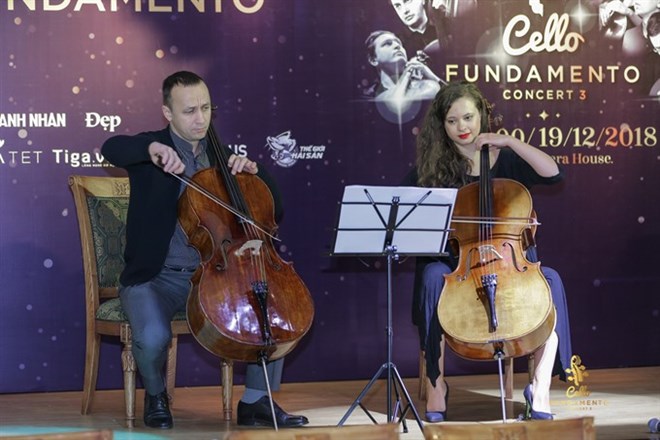



Razvan Suma and Ella Bokor (Romania) will perform at the Cello
Fundamento Concert 3 on December 19 (Photo: VNA)
Titled ‘Cello
Fundamento Concert 3’, the event will feature Razvan Suma (Romania),
Denis Severin (Switzerland), Stefan Cazacu (Romania), Mindaugas Bachus
(Litva), Chu Yi-Bing (China), Leonid Gorokhov (Germany), Ella Bokor (Romania),
Iulian Ochescu (Romania) and Dinh Hoai Xuan - the founder of Cello
Fundamento concerts.
The concert will feature various works such as Bolero by Maurice
Ravel, Elegie Op 24 by Gabriel Faure and Polonaise de Concert Op
14 by David Popper. The artists will perform in duo, trio and quartet and
with the symphony orchestra.
At a press conference last week, Xuan said the highlights of the show are
performances of Vietnamese song Tro Ve Dat Me (Return to the
Motherland) by composer Nguyen Van Thuong and the folk song Ly Ngua
O (Song of the Black Horse), which will be performed by all of the
artists.
The songs were adapted for cello by composer Luu Ha An, said Xuan.
The performance will also include drummer Nam Phan and singer Dieu Huong.
"I want to bring classical music, especially music from cello, closer to the
audience,” said Xuan.
Through this concert, Xuan said she also wants to promote cultural exchanges
between Vietnamese and foreign artists.
"It’s wonderful when Vietnamese and foreign artists perform music of the world
and of Vietnam on the same stage,” she said.
Xuan started studying music at the age of 10, with organ and piano at first,
before beginning a career as a cellist.
Currently, she is studying cello in Bucharest with a sponsorship from the
Government. She will finish a PhD thesis on performing and promoting cello
music in Vietnam next year.
Professor Suma is Xuan’s lecturer in Bucharest. He helped Xuan connect
international artists and invite them to join the concert.
He said it’s one among important events to promote cello music in Vietnam,
connecting musicians from Romania and other countries.
"I met Xuan for the first time three years ago, after one hour talking to her,
I realised that she is an interesting and ambitious artist who can help develop
cello and classical music in Vietnam,” said Suma.
"The relationship between Xuan and us is not one-way exchange because when she
comes to Romania, she brings Vietnamese culture to us. Now she brings us here
to know more about the local culture and introduce our music to the local
audience.”
Cellist Bokor said she was happy to come to Vietnam for the second time. She
also performed at the Cello Fundamento last year.
"I have many opportunities to discover the country and culture,” she said.
"Apart from the fact that I can’t eat dishes with much chili, I really love
Vietnamese cuisine and have tried most specialities in Hanoi.”
The Cello Fundamento Concert 1, first held in Hanoi, Hue and HCM City in 2016,
included performances by Xuan and three Romanian artists.
The second of its kind took place at the Hanoi Opera House in 2017, drawing
foreign artists from Romania, New Zealand, the US, Austria, Germany, and
Ukraine.
Source: VNA